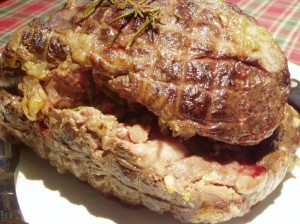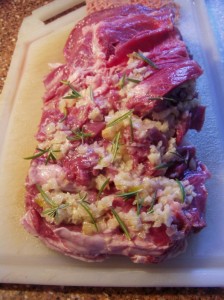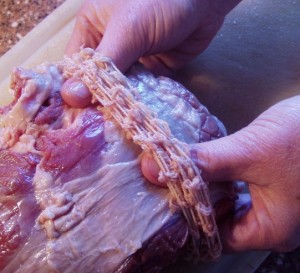 Yes, yes, I know, St. Patrick’s Day is coming up fast and the usual thing is corned beef and cabbage. But, let me make the case for something else: lamb.
Yes, yes, I know, St. Patrick’s Day is coming up fast and the usual thing is corned beef and cabbage. But, let me make the case for something else: lamb.
First, let’s look at this historically.
Anyone in Ireland who ate beef was probably a) rich and b) not Irish. Raising beef takes a lot of land. For the amount of land you need to raise a beef cow, you can raise a small herd of sheep. Which is why lamb and mutton has always been far more available and popular in Ireland than beef because even if you were a crofter and had only a small patch of land to work with, you could raise a bunch of sheep and have not only meat but also wool. So, if you want to be ‘Irish-Irish’, eating lamb is just more Irish than eating beef of any sort to celebrate St. Patrick’s Day.
Second, let’s look at this nutritionally.
Courtesy of our friends at nutrtional data, for a 3-ounce portion (and I think we can all accept that no one actually eats JUST a 3-ounce portion, but at least we are comparing ounce for ounce here.
Cooked Corned Beef…………………………….Roast Leg of Lamb
Calories: 210……………………………….220
Fat: 15 grams……………………………….15 grams
Protein: 15 grams……………………………..22 grams
Sodium: 960 mg……………………………….55 mg.
These last two are the bell-ringers here. Lamb, ounce for ounce, has more protein than beef does, though it does have the same amount of fat, so in terms of ‘protein bang for the buck’, lamb wins here. Secondly, and I think from a health perspective, even MORE importantly, corned beef is a just a huge sodium hit and I realize for a lot of people, that is the entire point of eating meats like corned beef and pastrami: they love the salt. Well, the salt does NOT love us or our hearts or blood pressure. That 3 ounces of corned beef (and again, who eats just a 3-ounce portion – that’s the size of a pack of cards) is way too much and let’s not even discuss anything else that will be eaten with the meal, like potatoes (going to salt those, too, right?). So, roast lamb wins out here too. Just 55 mg. of sodium. That’s one of those ‘pat myself on the back’ meals right there.
So. For those folks out there who have ‘Fear of Lamb’, here is Aunt Toby’s handy dandy so-simple it hurts roast leg of lamb.
You’ll need:
Meat thermometer or probe
Boneless leg of lamb roast – 3-5 pounds, fresh or defrosted, at room temperature
5 cloves of garlic, chopped fine.
Several sprigs of fresh rosemary with the leaves removed; save one for the top of the roast.
Small baking pan
One medium sized onion, sliced up
This is going to take a couple of hours, so don’t plan for this being something you can throw into the oven when you get home from work on Monday night, ok?
Pre-heat your oven to 350 degrees F.
Take your lamb roast. It is probably either trussed up with string or it’s in one of those elastic nets. Take off the net.
 Flip it open or unroll it depending on how the butcher did the deed. Take all the garlic and spread it onto the cut surface of the meat. Then sprinkle all the rosemary leaves on top. You should have the same amount of coverage as you see in the photograph here. Then take your black pepper grinder and grind a couple of good strong grinds of pepper on the surface. Then re-roll the roast or flip back the outside on top.
Flip it open or unroll it depending on how the butcher did the deed. Take all the garlic and spread it onto the cut surface of the meat. Then sprinkle all the rosemary leaves on top. You should have the same amount of coverage as you see in the photograph here. Then take your black pepper grinder and grind a couple of good strong grinds of pepper on the surface. Then re-roll the roast or flip back the outside on top.
Now, how are you going to make this thing hold together while it’s roasting. If it was trussed with string, use the string you took off to unroll it and wind it around again after you’ve rerolled it. If your meat came with one of those elastic nets on it, here is the way you get it back on again without the whole thing flipping out and ending in a wreck on the kitchen floor.
 Put the net over the ends of your hands, as in the photograph and put your hands over the closed end of the roast. Move your hands forward until you have the netting about half-way up the roast. Then take your hands out of the net. Use your fingers to pull the ends of the net over the front and back ends of the roast. Voila!
Put the net over the ends of your hands, as in the photograph and put your hands over the closed end of the roast. Move your hands forward until you have the netting about half-way up the roast. Then take your hands out of the net. Use your fingers to pull the ends of the net over the front and back ends of the roast. Voila!
Take your baking pan and put your sliced onions into the bottom in the center. Put the roast on top of that; this will prevent the roast from sticking to the bottom of the pan.
Put the pan into the 350 degree F. oven for 30 minutes. At the end of 30 minutes, turn the oven down to 170 degrees F or the lowest setting your oven has. Yes, I know this is sort of scary — but lamb does not take well to high heat. If you have horrific smell memories of Sunday lamb roasts, this is the reason why – the fat was burning in the high heat. Lamb does super well in ‘low and slow’ cooking. Leave your lamb at this low temperature for an hour and stick in the probe or meat thermometer to test the center for temperature. You are looking for 160 degrees F at the center. If it has already gotten to 140+ but you are looking to speed this up, you can raise the oven to 250 degrees F and the roast will not suffer – the outside will get a bit crunchy-er which some people like.
Once you have reached 160 degrees F at the center of the roast, take the pan out, wrap the meat in the foil tent and prepare the other side dishes (I am pushing Brussels Sprouts this week, but to each his own), and serve.
NO MINT JELLY.
Bon appetit!!
